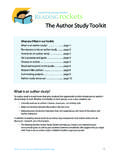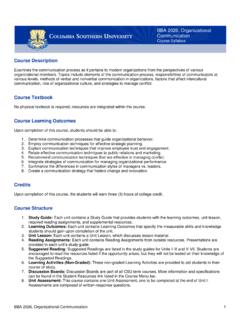Transcription of Teacher Support Materials for A2 Units Only - ocr.org.uk
1 GCE Health & Social Care A2 Support Materials 1 Teacher Support Materials for A2 Units Only Health and Social Care OCR Advanced GCE in Health and Social Care (H503) OCR Advanced GCE in Health and Social Care (Double Award) (H703) Version 12 GCE Health & Social Care A2 Support Materials Contents Contents 2 1 unit F919: Care practice and provision 3 Introduction 3 Guidance 5 Case study [1]: unit F919 Care practice and provision 7 Case study [2]: unit F919 Care practice and provision 8 Guidance from an expert: unit F919 Care practice and provision 9 2 unit F920: Understanding human behaviour and development 11 Introduction 11 Revision schedule: unit F920 Understanding human behaviour 13 3 unit F921: Anatomy and physiology in practice 15 Introduction 15 Revision schedule: unit F921 Anatomy and physiology in practice 17 4 unit F922: Child development 20 Int roduction 20 Case study [1]: unit F922 Child development 21 Case study [2]: unit F922 Child development 22 Guidance from an expert: unit F922 Child development 33 5 unit F923: Mental-health issues 34 Introduction: 34 unit F923: Mental Health Act 1983 Leaflet 6 - Detention under section 2 35 unit F923: Mental Health Act 1983 Leaflet 7 - Detention under section 3 37 unit F923: Patients Information Leaflet 21 - Mental Health Act 1983 Sections 26-30: 40 Case study [1]: unit F923 Mental-health issues 52 Case study [2]: unit F923 Mental-health issues 53 Guidance from an expert: unit F923 Mental-health issues 54 6 unit F924: Social trends 55 Introduction 55 Lesson plan: Social trends and patterns of family life 57 Marital breakdown and divorce 58 The changing position of children in the family 60 Guidance from an expert: unit F924 Social trends 61 Hints and tips unit F924 Social trends 62 7 unit F925: Research methods in health and social care 63 Introduction 63 Case study.
2 unit F925 Research methods in health and social care 64 Guidance from an expert: unit F925 Research methods in health and social care 66 8 Sample Assignments 69 Sample assignment unit F919: Care practice and provision 69 Sample assignment unit F922: Child development 72 Sample assignment unit F923: Mental health issues 75 Sample assignment unit F925: Research methods in health and social care 78 GCE Health & Social Care A2 Support Materials 3 1 unit F919: Care practice and provision Introduction Overview Meeting the needs of people who use services at local level How services and practitioners meet individual needs Ways in which practitioners within services work in multi-disciplinary teams How quality assurance is promoted by services Effects of national policy and legislation on care practice and provision Conducting a survey relating to quality assurance. This unit builds on knowledge skills and understanding gained from the mandatory AS Units to form the synoptic assessment element for these specifications.
3 Suitable teaching and learning strategies Visiting speakers from the local Primary Care Trust, NHS Trust, Social Services Simulated exercises to plan provision using demographic data, national targets and an allocated budget Presentation of demographic data for the local area Evaluation of a copy of the local plan Interviewing practitioners/people who use services Interviewing quality assurance specialist/speaker from local Trust Hospital Work placements/work shadowing Role-play, case studies, videos of TV programmes Casualty Group discussion/debate of the effects of national policies and legislation on care practice and provision Mini/trial surveys. 4 GCE Health & Social Care A2 Support Materials Possible pitfalls Covering too many/inappropriate demographic characteristics Poor choice of people who use services must be someone who uses two different local services Approaches not relevant to the practitioners/services Limited detail relating to how the practitioners meet the needs of the people who use services Lack of relevant detail about the methods/interactions/processes used when multi-disciplinary teams work together Quality assurance mechanisms do not link to the two chosen services Depth of evidence does not meet the requirements of analyse National policy/legislation does not link to the people who use services or services chosen Lack of/inaccurate use of specialist terms Evaluation does not link to the views of the people who use services/practitioner or the service.
4 Resources Our Healthier Nation Local Health Improvement plan Local demographic statistics (available on local authority website) A2 GCE Health and Social Care for OCR; Heinemann Sociology textbooks Local Education department (early years) and Early Years Development and Childcare Partnerships Local Primary Care Trusts and other NHS Trusts Local Social Services departments Private organisations Voluntary organisations Various websites (see specifications). GCE Health & Social Care A2 Support Materials 5 Guidance Guidance on demographic influences Demographic influences have a direct impact on the planning and delivery of health, social care and early years services to meet the needs of services users at a local level. Services work together to ascertain the requirements before joint planning takes place. Demographic factors which are considered include: The health needs of the population: these can be assessed using statistics of incidences of disease and illnesses, hospital admissions, A&E admissions.
5 Lifestyle choices of smoking, alcohol abuse, poor diet, drug abuse, stress and lack of exercise also contribute to the health needs of the local population which have to be planned for. Disability: there has been a decrease in the numbers of certain infectious diseases due to the effectiveness of the immunisation programmes; however, there has been an increase in the numbers of degenerative diseases like cancer, heart disease and strokes. Some areas may have higher incidences of inherited conditions which would put pressure on the local provision. Age of populations: the variations in numbers of different age brackets within a population can be used to plan the services required. Each life-stage has specific needs. Birth rates are used to project the needs for pre-school and education provision. The numbers of adolescents may link to the needs for family planning, contraceptives, GUM clinics and alcohol/drug related services. The numbers of young adults could be used to plan pregnancy and maternity services as this is a time when people of this age tend to plan to have their families.
6 The average life expectancy has increased over the last century which means there is greater cost for the provision of services. The cost of providing health and social care services varies according to age knowing the age profile of the area enables the costing of service provision to be determined when applying for government funding. Unemployment: the socio-economic status of an area is an indicator which is used to assess the health needs and provision of services required. Health Action Zones were introduced in areas of social deprivation to try and address the inequalities in health care provided. The income of a family has an impact of the diet, housing, exercise and stress levels which, in turn, can have a correlation to incidences of disease and increased health needs. 6 GCE Health & Social Care A2 Support Materials Numbers of single parent families: changes in family patterns have seen an increase in divorces and women deciding to have children without a partner to Support them.
7 There has also been an increase in the numbers of teenage mothers. If single parents want to work there is increased demand for childcare places and consequently the need for pre-school provision has risen. The number of older people in the UK population: the number of older people in the population rose rapidly over the last century. In 1901, there were less than 2 million people over the age of 65. The number of over-65s is now over 9 million. This growth is projected to continue. By 2051 there are projected to be over 15 million people over 65. The care needs of older people are significantly more than those of younger people, the average treatment cost per person among the pver-85s is more than five times that of the 45 64 age group therefore, a local area must consider this aspect when planning the provision of services. The number of older people in the local population could have an impact on the provision of residential and nursing homes, domiciliary care services, day centres, mental health services, intermediate care provision, and community care services.
8 Sources of information: Local authority websites: , NHS Strategic Health Authority: For example, South West Peninsula Strategic Health Authority NHS Trusts: Primary Care Trust: for example: Office for National Statistics: Neighbourhood Statistics: General Household Survey: Department for Health: Surestart: Local NHS Delivery Plans Local Health Improvement Plans Sociology Textbooks Social Trends: HMSO. GCE Health & Social Care A2 Support Materials 7 Case study [1]: unit F919 Care practice and provision Adam is a 19 year old student. He has just finished his A levels and is going to start university. His family and friends have noticed that he has been fairly withdrawn recently and his personal hygiene is deteriorating. He spends long periods of time in his room and will not socialise with his friends. Initially his mother persuaded him to see his GP and he was given mild antidepressants but then the situation got much worse and Adam attempted to take his own life.
9 He was sectioned under the Mental Health Act and admitted to a local mental health unit . He spent three weeks there after being diagnosed with schizophrenia. During his time at the unit he spent time sorting his medication out and coming to terms with his diagnosis. He has since been discharged and is now under the care of adult community care services for adults. In the town where Adam lives, the local NHS and Social Services have merged to form an NHS and Social Care Trust. AO1 Generic requires candidates to look at two local demographic characteristics and show how these influence service provision. The 2 required could relate to your case study. Which organizations are involved in planning and delivering services in your area? How are the person who uses services needs identified and met? Identify the stages undertaken at local planning level, how plans are produced, the role of stakeholders. Who would be involved in the planning? How do they monitor and evaluate the planning process?
10 AO2 Candidates need to pick one national policy or piece of legislation which relates to Adam and the services chosen. They need to say how it has affected the people who use services and service provider/practitioner (for mark band 3), providing an evaluation which draws valid conclusions of the overall effect of the legislation. For example, the NHS and Community Care Act 1990, the Mental Health Act 1983, the Health Act 1999 or the Care Standards Act 2000. If you want to look at a policy the NICE guidelines would be appropriate. AO3 Candidates need to find out what quality assurance mechanisms each of the services use. For example, look on the NHS website for star rating of the NHS and Social Care trust or do day services have feedback mechanisms for people who use services and their families? They could ask care workers and people who use services (if appropriate) their opinions of the services, using the internet or organizational documents to look at actual quality assurance (note: primary and secondary methods required for mark band 3).
















